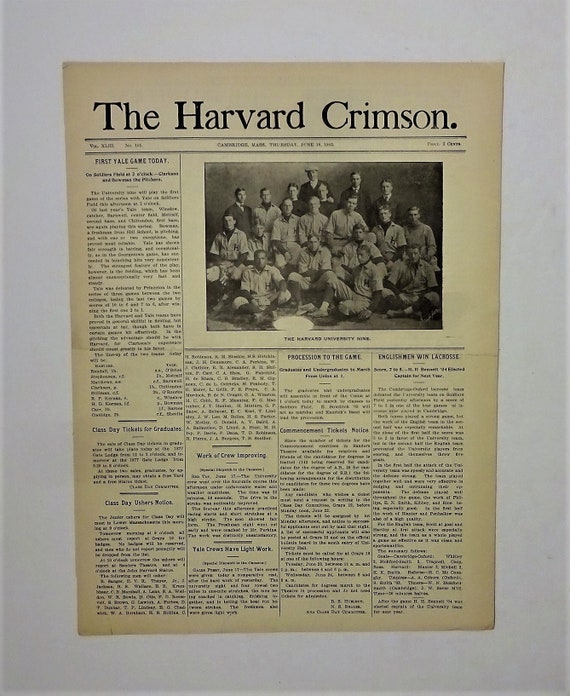Unveiling The Legacy Of The Harvard Crimson Newspaper: A Pillar Of Campus Journalism
There’s something magical about stepping onto the Harvard campus for the first time. The grandeur, the history, and the stories that echo through its hallowed halls make it a place like no other. And at the heart of this storied institution lies the Harvard Crimson Newspaper, a publication that has not only chronicled the lives of students but also shaped public discourse for over a century. If you’re here, chances are you’re curious about the legacy of this iconic paper, and let me tell you, we’re about to dive deep into its rich history, impact, and why it remains a pillar of campus journalism.
Now, before we get into the nitty-gritty, let’s talk about why the Harvard Crimson matters so much. It’s not just another college newspaper—it’s a platform where future leaders, thinkers, and change-makers cut their teeth in the world of journalism. For decades, it’s been a voice for students, faculty, and the broader community, tackling everything from campus politics to global issues. Think of it as the beating heart of intellectual debate on campus.
What makes the Harvard Crimson truly special is its commitment to excellence. In an era where journalism faces challenges left, right, and center, this paper stands tall as a beacon of integrity and dedication. So buckle up, because we’re about to explore its storied past, its impact on journalism, and what the future holds for this legendary publication.
Read also:Lol Worlds 2024 Schedule Everything You Need To Know About The Upcoming Esports Extravaganza
Table of Contents
- A Journey Through Time: The History of the Harvard Crimson
- Biography of the Harvard Crimson: The Who, What, and Why
- The Impact on Campus Culture
- A Pillar of Journalism: Standards and Practices
- Challenges Faced by the Harvard Crimson
- Innovations in Campus Journalism
- Unveiling the Legacy: Contributions to Modern Journalism
- The Future of the Harvard Crimson
- Key Statistics and Data
- Conclusion: Why the Harvard Crimson Matters
A Journey Through Time: The History of the Harvard Crimson
Let’s rewind the clock and take a trip down memory lane. The Harvard Crimson Newspaper was founded way back in 1873, making it one of the oldest continuously published daily college newspapers in the United States. Back then, it wasn’t just a newspaper—it was a movement. Imagine a group of passionate students gathering in a dimly lit room, scribbling notes, and debating the issues of the day. That’s how it all began.
Over the years, the Harvard Crimson has evolved, adapting to the changing times while staying true to its core mission. From typewriters to digital platforms, it’s seen it all. But what’s truly remarkable is how it’s managed to maintain its relevance and influence. In fact, the paper has been at the forefront of covering major events, both on campus and beyond. Whether it’s the Vietnam War protests or the rise of tech startups in Cambridge, the Crimson has been there, capturing it all.
Now, here’s the kicker—this isn’t just a history lesson. Understanding the roots of the Harvard Crimson gives us insight into its enduring legacy. It’s not just about reporting the news; it’s about shaping the narrative and holding power to account. And that’s something worth celebrating.
Biography of the Harvard Crimson: The Who, What, and Why
Alright, let’s break it down. Who exactly is behind the Harvard Crimson? Well, it’s run entirely by students, which is pretty impressive when you think about it. These aren’t just any students, either—they’re some of the brightest minds from across the globe. And what do they do? They produce award-winning journalism, plain and simple.
Here’s a quick snapshot of the key players:
Key Facts About the Harvard Crimson
| Founder | Harvard Students |
|---|---|
| Year Founded | 1873 |
| Publication Frequency | Daily during the academic year |
| Staff Size | Over 200 student journalists |
| Notable Alumni | George Stephanopoulos, Doris Kearns Goodwin, and many more |
Why does the Harvard Crimson exist? Simple—it’s to give students a voice. It’s a platform for them to express their ideas, challenge the status quo, and make a difference. And let’s be real, in today’s world, having a platform like this is more important than ever.
Read also:Howie Long Jr The Legacy Career And Impact That Shaped A Dynasty
The Impact on Campus Culture
The Harvard Crimson isn’t just a newspaper—it’s a cultural institution. Its influence extends far beyond the pages of its publication. Think about it—when a major issue arises on campus, the Crimson is often the first to report on it. From debates over affirmative action to discussions about mental health, the paper plays a crucial role in shaping public opinion.
But it’s not just about the news. The Crimson also hosts events, panels, and discussions that bring the community together. It’s a space where diverse voices can be heard, and that’s something we should all appreciate. In a world that sometimes feels divided, the Crimson serves as a unifying force.
And let’s not forget the impact it has on individual students. Many of those who work for the paper go on to have successful careers in journalism, politics, and other fields. It’s like a launchpad for greatness, and that’s pretty cool if you ask me.
A Pillar of Journalism: Standards and Practices
When it comes to journalism, the Harvard Crimson sets the bar high. Its staff adheres to strict standards of accuracy, fairness, and transparency. They know that with great power comes great responsibility, and they take that responsibility seriously.
Here’s how they do it:
- Fact-checking every article before publication
- Encouraging diverse perspectives in reporting
- Promoting ethical practices in journalism
These practices aren’t just lip service—they’re ingrained in the culture of the paper. And it shows. The Harvard Crimson has won numerous awards for its journalism, including the prestigious Pulitzer Prize. That’s not something you see every day, folks.
Challenges Faced by the Harvard Crimson
Of course, no story is complete without its challenges. The Harvard Crimson, like many other publications, faces its fair share of hurdles. From dwindling ad revenue to the rise of social media, the landscape of journalism has changed dramatically over the years.
But here’s the thing—the Crimson doesn’t shy away from these challenges. Instead, it embraces them. The staff is constantly innovating, finding new ways to reach readers and tell stories. They’ve launched digital platforms, podcasts, and even video content to keep up with the times. And guess what? It’s working.
Still, there are critics who question the paper’s objectivity and influence. Some argue that it’s too liberal, while others say it doesn’t do enough to represent all voices. But isn’t that the beauty of journalism? It’s a conversation, not a monologue.
Innovations in Campus Journalism
Speaking of innovation, the Harvard Crimson is leading the charge when it comes to campus journalism. They’ve embraced technology in ways that many other publications have yet to catch up with. From interactive graphics to virtual reality experiences, they’re pushing the boundaries of what journalism can be.
Here are a few examples of their innovative projects:
- Interactive maps showing campus demographics
- Virtual tours of Harvard’s historic buildings
- Podcasts featuring interviews with notable alumni
These projects not only engage readers but also provide valuable learning opportunities for the student journalists involved. It’s a win-win situation, really.
Unveiling the Legacy: Contributions to Modern Journalism
So, what’s the legacy of the Harvard Crimson? It’s simple—this paper has left an indelible mark on the world of journalism. Its commitment to excellence, its dedication to truth, and its willingness to innovate have inspired countless others. It’s not just a campus newspaper—it’s a model for what journalism can and should be.
And let’s not forget the impact it’s had on individual lives. Many of the world’s most prominent journalists, politicians, and thinkers got their start at the Crimson. It’s like a Who’s Who of influential figures, and that’s something to be proud of.
But the legacy isn’t just about the past—it’s about the future. As long as there are passionate students willing to tell stories, the Harvard Crimson will continue to thrive. And that’s something we can all look forward to.
The Future of the Harvard Crimson
What does the future hold for the Harvard Crimson? Well, one thing’s for sure—it’s going to be exciting. With advancements in technology and changes in the media landscape, the possibilities are endless. Imagine a world where virtual reality storytelling is the norm or where AI-powered journalism becomes a reality. The Crimson is already exploring these frontiers, and I can’t wait to see what they come up with next.
But it’s not just about technology. The future of the Harvard Crimson is also about diversity and inclusion. As the world becomes more interconnected, the paper has an opportunity to amplify underrepresented voices and tell stories that matter. And that’s something we should all support.
So, whether you’re a current student, an alum, or just a curious reader, the Harvard Crimson has something to offer you. It’s not just a newspaper—it’s a movement, a community, and a source of inspiration.
Key Statistics and Data
Let’s wrap things up with some numbers. Here are a few key statistics about the Harvard Crimson:
- Over 140 years of continuous publication
- More than 200 student journalists contributing annually
- Recipient of numerous awards, including the Pulitzer Prize
- Reaching thousands of readers both on and off campus
These numbers don’t just tell a story—they tell a legacy. And it’s a legacy worth celebrating.
Conclusion: Why the Harvard Crimson Matters
So, there you have it—the legacy of the Harvard Crimson Newspaper. From its humble beginnings in 1873 to its status as a pillar of campus journalism today, this paper has made an undeniable impact. It’s not just about reporting the news—it’s about shaping the narrative, amplifying voices, and inspiring change.
As we look to the future, one thing is clear—the Harvard Crimson will continue to play a vital role in journalism. Whether it’s through innovative storytelling, diverse representation, or cutting-edge technology, the paper will remain a beacon of excellence.
And here’s the thing—you don’t have to be a Harvard student to appreciate what the Crimson has to offer. So, why not take a moment to check out their latest stories? You might just discover something that inspires you.
Until next time, keep reading, keep thinking, and keep making a difference. The world needs more voices like the Harvard Crimson, and I, for one, am grateful for everything they do.


